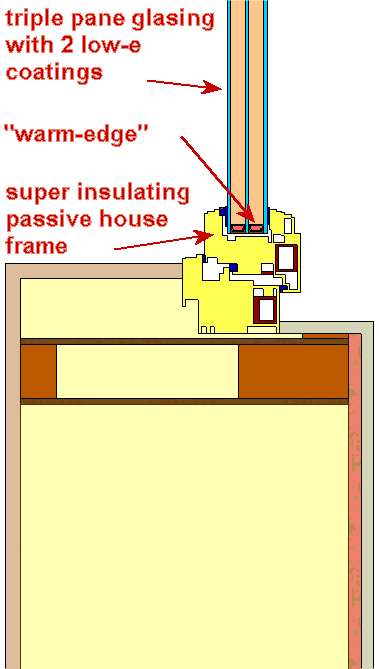| |
Windows for Passive Houses |
|

A Passive House window with an Uw-value lower than 0.8 W/(m²K) assures a high thermal comfort.
To build Passive Houses, highly efficient windows have to be used. The type of glazing and frames will depend on climate, however. In the Central European climate there are three essentials:
- Triple glazing with two low-e-coatings (or another combination of panes giving a comparable low heat loss)
- "Warm Edge" - spacers,
- Super-insulated frames.
These components harmonize
in a way that the total heat loss of such a window is only half as high
as compared to a conventional new window. But direct and indirect solar
gains are collected through the glazing, too. Therefore, it has been demonstrated
that by using these highly efficient windows, the result will be a positive
energy balance even in the Central European winter period, as long as
the orientation is suitable and the shading not excessive.
The thermal loss coefficients, Uw, of such Passive House windows
are lower than 0.8 W/(m²K) according to the new European standard
(EN 10077). One consequence of such a low heat loss is that the interior
surface temperature of such a window, even in cold European winter nights,
will exceed 17 °C. This results in excellent thermal comfort even
near the window: There will be neither trouble with "cold radiation"
from the window nor an unpleasant lake of cold air at the floor.
The 17 °C condition for minimum internal surface temperatures of windows
in a Passive House is the defining requirement for Passive House windows
in any given climate.
Additional information on Passive House windows.
11th Conference on Passive
Houses:
Experience with good thermal comfort will be discussed in the Workshop
on High Thermal Comfort.
Passive House windows of various types will be presented at the exhibition.
Note that these products, representing the highest state of window technology
in Europe, are suitable for retrofit of existing buildings as well.
(updated: 2006-09-23 thanks
to Dylan Lamar for proof reading of the 1st edition
© Passive House Institute;
unchanged copy is permitted, please give reference to this page)